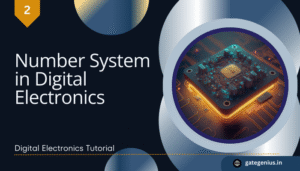In digital electronics, representing and handling negative binary numbers is an essential topic. To make this process efficient, we use complement systems—primarily 1’s complement and 2’s complement. These methods play a vital role in complement in digital electronics, enabling accurate representation and arithmetic operations on signed binary numbers. Whether you are preparing for GATE, UGC NET, or simply studying digital electronics, a clear understanding of these complement techniques is fundamental.
What is 1’s Complement in Digital Electronics?
1’s complement of a binary number is formed by inverting each bit—changing 0 to 1 and 1 to 0. It is mostly used to represent the negative of a binary number in older computer systems.
How to Find 1’s Complement:
To find the 1’s complement:
- Take the binary representation of a number.
- Flip all bits (invert the bits).
Example:
Let’s find the 1’s complement of 0101 (which is +5 in 4-bit binary):
Original: 0101
1’s Comp: 1010
So, 1’s complement of +5 is 1010, which represents -5 in 1’s complement form (in 4 bits).
What is 2’s Complement?
2’s complement is the most widely used method to represent signed binary numbers. It allows straightforward binary subtraction and eliminates the issue of having +0 and -0 (which exists in 1’s complement).
How to Find 2’s Complement:
There are two methods:
Method 1:
- Find the 1’s complement.
- Add 1 to the result.
Method 2:
- From the right, keep all bits up to (and including) the first 1 unchanged.
- Flip all bits to the left of that.
Example:
Let’s find the 2’s complement of 0101 (+5 in 4-bit binary):
Step 1: Find 1’s complement → 1010
Step 2: Add 1
1010
+ 0001
= 1011
So, the 2’s complement of 0101 is 1011, which represents -5 in 2’s complement form.
Difference Between 1’s and 2’s Complement
| Feature | 1’s Complement | 2’s Complement |
|---|---|---|
| How it works | Inverts all bits | Invert + add 1 |
| Arithmetic ease | Complex | Simple |
| Zero representations | Two (positive and negative zero) | Only one zero |
| Preferred system | Rarely used today | Widely used in systems |
Why is 2’s Complement Preferred?
2’s complement is widely preferred in digital electronics because it offers several important advantages that make signed binary arithmetic simpler and more reliable. One of the key reasons is that it provides only one unique representation of zero, unlike other methods. This clear representation reduces ambiguity and potential errors when handling signed numbers. The concept of complement in digital electronics—especially the 2’s complement system—plays a crucial role in making arithmetic operations such as addition and subtraction more efficient and easier to implement in modern digital circuits.
1. Only One Representation of Zero
In 2’s complement, zero has a unique representation, unlike 1’s complement which has two (positive zero and negative zero). This eliminates ambiguity and simplifies error checking in digital systems.
2. Simplifies Binary Subtraction
2’s complement allows subtraction to be performed as simple addition of the complement, removing the need for separate subtraction circuits. This makes arithmetic operations faster and more efficient.
3. Easier to Implement in Hardware
Because 2’s complement arithmetic can use the same circuitry for addition and subtraction, it reduces hardware complexity. This leads to cost-effective and reliable digital designs.
FAQs on 1’s and 2’s Complement
Q1. What is the main use of 1’s complement?
A: It was used in early computer systems for representing negative numbers but is rarely used now.
Q2. How is 2’s complement different from 1’s complement?
A: 2’s complement adds 1 to the 1’s complement and solves the problem of dual-zero representation.
Q3. Can we convert 2’s complement back to original binary?
A: Yes, take the 2’s complement again to get the original positive binary number.
Q4. Why do modern systems use 2’s complement?
A: Because it simplifies subtraction and hardware design.
Q5. Is there any shortcut to find 2’s complement?
A: Yes, leave bits after the first 1 (from the right) unchanged, and flip all the bits to the left of it.
Q6. What does 1111 represent in 2’s complement (4-bit)?
A: It represents -1.
Conclusion
Understanding 1’s and 2’s complement is fundamental for working with negative binary numbers in digital electronics. These methods allow digital systems to represent and manipulate signed numbers efficiently. While 1’s complement is mostly historical and rarely used in modern designs, 2’s complement remains the standard for signed binary arithmetic because of its simplicity, ease of implementation, and ability to avoid issues like multiple representations of zero. Mastering the concept of complement in digital electronics is essential for anyone working with arithmetic operations, computer architecture, and digital system design, as it underpins many critical computations in processors and embedded systems.
I hope you understand the 1’s and 2’s complement in digital electronics. So don’t forget to share this post with friends and anyone preparing for the GATE, UGC NET exams, or studying at the university.



